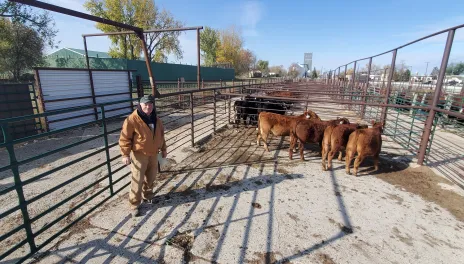A Quarter Century of the Dakota Feeder Calf Show
While the Dakota Feeder Calf Show started 25 years ago, the NDSU Carrington Research Extension Center has been feeding these calves to finish for 23 years. Show consignments vary each year, but individual feeding and carcass data has been provided for over 4,000 steers since the show began.
The Dakota Feeder Calf Show is set for October 21, 2023, in Turtle Lake, ND at the Turtle Lake Weigh Station.
Interested consignors will deliver 500- to 700-pound steer calves before 10 a.m. CST on the day of the show. Each producer can consign one or two pens containing three or four calves. The calves are exhibited and evaluated that afternoon, trophies and cash prizes are awarded, and then the calves are shipped to the Carrington REC feedlot to be fed to a finished market weight.
“After 24 years of comparing calf performance, North Dakota cattle ranchers are finding superior growth and carcass characteristics,” says Karl Hoppe, Extension livestock specialist at the Carrington center. “Since cow herd genetics can change over time via bull and heifer selection, sending cattle to the Dakota Feeder Calf Show feedout gives the rancher information on how their selections are advancing their herd.”
“There are several ways to collect growth performance carcass data from your calves,” says Colin Tobin, animal scientist at the Carrington REC. “The best is to feed out your entire calf crop. That takes considerable time, effort and funds. An alternative is to consign a group of calves to a feedout project. Your risk is less and a feedout project provides a substantial amount of information about the calves.”
Dakota Feeder Calf Show chair Darwin Chesrown has been consigning calves since the feedout started.
During the 2022-23 feedout, the calves gained an average of 724 pounds in 228 days, with a total feeding cost (excluding interest) of $1.15 per pound of gain. The average sale weight was 1,325 pounds. The calves were fed with a market weight break-even point of $150.57 per hundredweight.
"It's the variation among cattle that makes this project educational and a real eye-opener," Hoppe says.
In the 2022-23 feedout, the spread in net return per head between the average of the top and bottom five herds was $312.11. The spread between the top and bottom herd was more noticeable at $462.95 per head. Average daily weight gain in the feedlot was 3.8 pounds for the top-profiting herd and 3.1 pounds for the bottom herd.
Feedout project staff will gather data on the rate of gain, feeding costs and other characteristics during the trial. After the calves are marketed, the staff will collect and provide information related to carcass weight, meat quality, feeding expenses and value.
Calves destined for the show should be pre-vaccinated for BVD, PI3, IBR and BRSV, Mannheimia, Clostridials and histophilus somni. Booster vaccinations will be administered upon delivery to the show.
Producers will be assessed an entry fee of $20 per calf. Dakota Feeder Calf Show officials will present awards to producers at the end of the trial.
For more information or to preregister calves, contact Hoppe or Tobin at 701-652- 2951 (office), 701-650-8810 (cell) or karl.hoppe@ndsu.edu, or Chesrown, Dakota Feeder Calf Show Committee, at 701-448-9286.
Karl Hoppe, Ph. D.
Karl.Hoppe@ndsu.edu
Extension Livestock Systems Specialist
